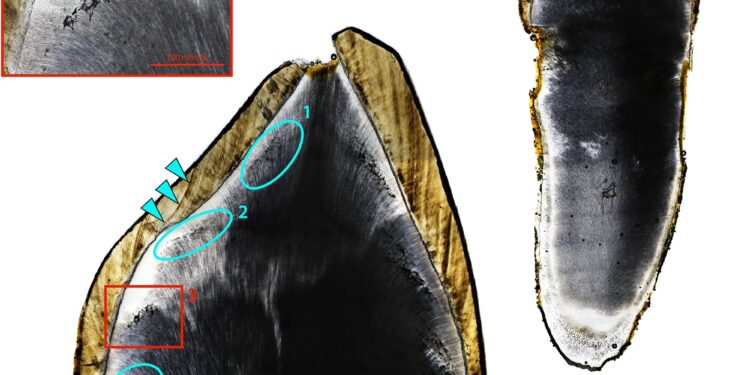Right permanent maxillary canine of CL 129. Four discrete episodes of IGD (interglobular dentin) in approximately annual increments are apparent. The turquoise arrows indicate a Wilson group formed at the same time as the 2nd episode of IGD. Credit: Snoddy et al., 2024, PLOS ONE, CC-BY 4.0 (creativecommons.org/licenses/by/4.0/)
Evidence from teeth reveals that vitamin D deficiency during childhood was likely a major problem in industrialized England, according to a study published January 31, 2024 in the open access journal. PLOS ONE by Anne Marie Snoddy of the University of Otago, New Zealand and colleagues.
The 18th and 19th centuries CE were a period of industrialization and urbanization in England. It was also a time of increasing incidence of health problems such as vitamin D deficiency (VDD) and associated diseases such as rickets, potentially linked to changing social practices linked to social class and gender.
At the Coach Lane cemetery site in northern England, previous work identified rickets based on skeletal lesions. In this study, Snoddy and colleagues build on this research with new analyzes of dental tissues.
The researchers examined the teeth of 25 individuals preserved at the site. The presence of poorly mineralized dentin tissue has been used as evidence of periods of VDD during childhood, and analysis of enamel peptides has identified the chromosomal sex of some of these individuals.
This analysis found that approximately three-quarters of the individuals examined showed signs of poor mineral metabolism during childhood, with a significantly higher incidence in males. Some individuals also showed signs of repeated annual disruptions in tooth tissue development, suggesting a seasonal disorder.
These results reveal a higher prevalence of VDD compared to previous studies relying on skeletal evidence. The high incidence of DMV in men compared to women could be linked to social dynamics such as gendered working practices in industrial England.
The authors suggest that future work could expand on these findings by exploring other proxies for VDD and related disorders, as well as comparing sites in different parts of the world.
The authors add: “We found clear evidence of seasonal vitamin D deficiency in the teeth of people living in the north of England. This is exciting because it highlights that latitude and seasonal lack of sunlight were a major factor in the amount of vitamin D in these people. what people could do in their own skin – it’s more complicated than factors associated with the industrial revolution like working more indoors.
More information:
Vitamin D status in post-medieval northern England: insights from dental histology and enamel peptide analysis at Coach Lane, North Shields (AD 1711–1857), PLoS ONE (2024). DOI: 10.1371/journal.pone.0296203
Provided by the Public Science Library
Quote: Archaeological evidence of seasonal vitamin D deficiency discovered in England (January 31, 2024) retrieved January 31, 2024 from
This document is subject to copyright. Except for fair use for private study or research purposes, no part may be reproduced without written permission. The content is provided for information only.



